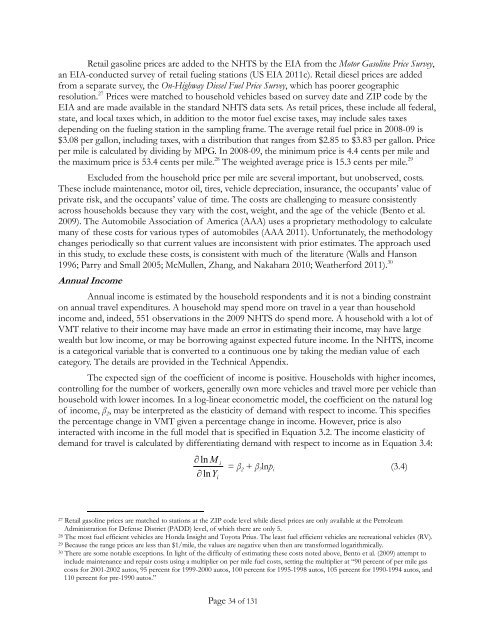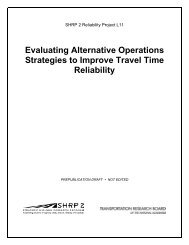Mileage-Based User Fee Winners and Losers - RAND Corporation
Mileage-Based User Fee Winners and Losers - RAND Corporation
Mileage-Based User Fee Winners and Losers - RAND Corporation
Create successful ePaper yourself
Turn your PDF publications into a flip-book with our unique Google optimized e-Paper software.
Retail gasoline prices are added to the NHTS by the EIA from the Motor Gasoline Price Survey,<br />
an EIA-conducted survey of retail fueling stations (US EIA 2011c). Retail diesel prices are added<br />
from a separate survey, the On-Highway Diesel Fuel Price Survey, which has poorer geographic<br />
resolution. 27 Prices were matched to household vehicles based on survey date <strong>and</strong> ZIP code by the<br />
EIA <strong>and</strong> are made available in the st<strong>and</strong>ard NHTS data sets. As retail prices, these include all federal,<br />
state, <strong>and</strong> local taxes which, in addition to the motor fuel excise taxes, may include sales taxes<br />
depending on the fueling station in the sampling frame. The average retail fuel price in 2008-09 is<br />
$3.08 per gallon, including taxes, with a distribution that ranges from $2.85 to $3.83 per gallon. Price<br />
per mile is calculated by dividing by MPG. In 2008-09, the minimum price is 4.4 cents per mile <strong>and</strong><br />
the maximum price is 53.4 cents per mile. 28 The weighted average price is 15.3 cents per mile. 29<br />
Excluded from the household price per mile are several important, but unobserved, costs.<br />
These include maintenance, motor oil, tires, vehicle depreciation, insurance, the occupants’ value of<br />
private risk, <strong>and</strong> the occupants’ value of time. The costs are challenging to measure consistently<br />
across households because they vary with the cost, weight, <strong>and</strong> the age of the vehicle (Bento et al.<br />
2009). The Automobile Association of America (AAA) uses a proprietary methodology to calculate<br />
many of these costs for various types of automobiles (AAA 2011). Unfortunately, the methodology<br />
changes periodically so that current values are inconsistent with prior estimates. The approach used<br />
in this study, to exclude these costs, is consistent with much of the literature (Walls <strong>and</strong> Hanson<br />
1996; Parry <strong>and</strong> Small 2005; McMullen, Zhang, <strong>and</strong> Nakahara 2010; Weatherford 2011). 30<br />
Annual Income<br />
Annual income is estimated by the household respondents <strong>and</strong> it is not a binding constraint<br />
on annual travel expenditures. A household may spend more on travel in a year than household<br />
income <strong>and</strong>, indeed, 551 observations in the 2009 NHTS do spend more. A household with a lot of<br />
VMT relative to their income may have made an error in estimating their income, may have large<br />
wealth but low income, or may be borrowing against expected future income. In the NHTS, income<br />
is a categorical variable that is converted to a continuous one by taking the median value of each<br />
category. The details are provided in the Technical Appendix.<br />
The expected sign of the coefficient of income is positive. Households with higher incomes,<br />
controlling for the number of workers, generally own more vehicles <strong>and</strong> travel more per vehicle than<br />
household with lower incomes. In a log-linear econometric model, the coefficient on the natural log<br />
of income, β 2 , may be interpreted as the elasticity of dem<strong>and</strong> with respect to income. This specifies<br />
the percentage change in VMT given a percentage change in income. However, price is also<br />
interacted with income in the full model that is specified in Equation 3.2. The income elasticity of<br />
dem<strong>and</strong> for travel is calculated by differentiating dem<strong>and</strong> with respect to income as in Equation 3.4:<br />
ln M<br />
lnY<br />
i<br />
i<br />
= β 2 + β 7 lnp i (3.4)<br />
27 Retail gasoline prices are matched to stations at the ZIP code level while diesel prices are only available at the Petroleum<br />
Administration for Defense District (PADD) level, of which there are only 5.<br />
28 The most fuel efficient vehicles are Honda Insight <strong>and</strong> Toyota Prius. The least fuel efficient vehicles are recreational vehicles (RV).<br />
29 Because the range prices are less than $1/mile, the values are negative when then are transformed logarithmically.<br />
30 There are some notable exceptions. In light of the difficulty of estimating these costs noted above, Bento et al. (2009) attempt to<br />
include maintenance <strong>and</strong> repair costs using a multiplier on per mile fuel costs, setting the multiplier at “90 percent of per mile gas<br />
costs for 2001-2002 autos, 95 percent for 1999-2000 autos, 100 percent for 1995-1998 autos, 105 percent for 1990-1994 autos, <strong>and</strong><br />
110 percent for pre-1990 autos.”<br />
Page 34 of 131















